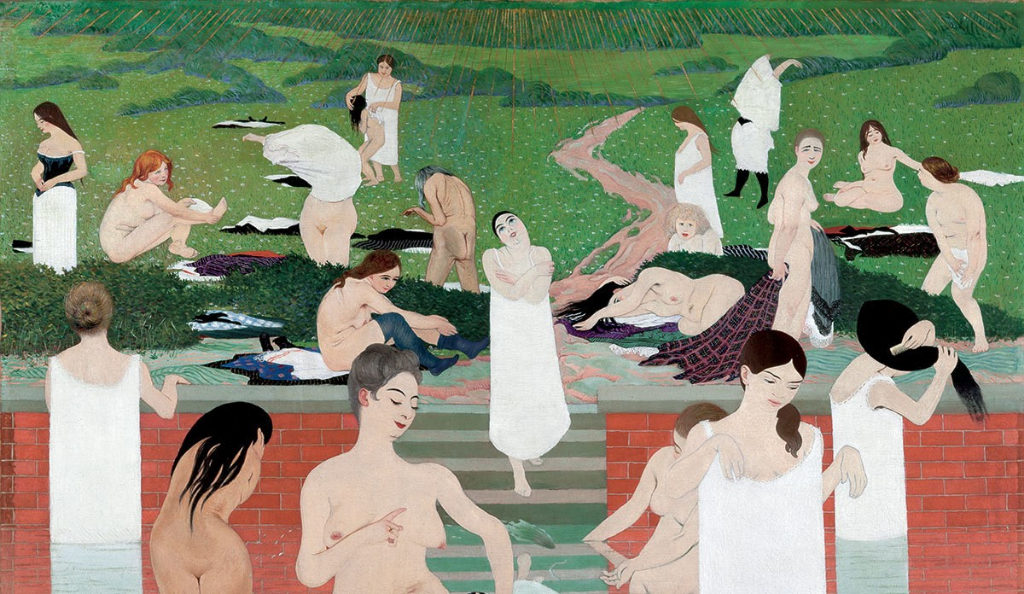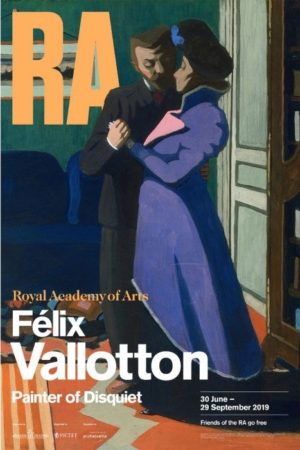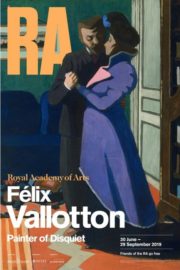Félix Vallotton: Painter of Disquiet at the Royal Academy of Arts

In 1882, at the age of 16, the young Swiss artist Félix Vallotton took the bold decision to move from his native Lausanne to Paris. The French capital of the Belle Époque was pulsating with modernistic vitality, attracting artists from every corner of the globe.
Vallotton enrolled at the Académie Julian, studying alongside future fellow “Nabis” (“Prophets”) Pierre Bonnard and Édouard Vuillard. Over the course of his subsequent career, the painter would show a particular talent for the capturing of the ceaseless ebb and flow of modern Parisienne life, as well as domestic narratives behind closed doors.
The Royal Academy’s current retrospective on the artist features some 100 paintings and prints, drawing on his portraits, atmospheric interiors, landscapes and satirical prints of fin de siècle French society. Today, Vallotton is comparatively unknown in this country, the most recent previous exhibition in the UK being in 1976. He enjoys a bigger reputation in Switzerland, the country of his birth, where a substantial amount of his work is to be found.
The opening room sees the young artist’s initial development as a Naturalistic painter. His sideways glancing Self-portrait at the Age of Twenty (1885), an oil work awarded a distinction by the Academie Julian, testifies in its precision to his interest in Holbein at the time.
The year of 1891-92 was clearly a hugely transitional one for the artist, as highlighted by two works, The Sick Girl (1892) and Bathing on a Summer Evening (1892-93). In the former, Vallotton achieves a high degree of realism, capturing bottles’ reflections and polished furniture. Oddly, however, he chooses to obscure the face of the young woman (modelled by his then-lover, Hélène Chatenay) by angling the bed away from the viewer. Similarly curious twists appear in other interior compositions here by the artist. The Sick Girl has an additional peculiarity in the sense that the maid entering the room appears to be walking towards the viewer, akin to an actress addressing her audience, seemingly oblivious to her patient.
1892 saw the subject increasing his artistic ties with the radical young Symbolist painters, Les Nabis, including Édouard Vuillard, who became a close friend. Vallotton was called “the Foreign Nabi” due to his Swiss origins. Arguably, his most memorable Nabi painting is Bathing on a Summer Evening, which caused considerable controversy. Its figures are notable for their flattened and stylised manner. Women of every agegroup are shown in varying states of undress. They appear collage-like onto a bucolic background of pastoral meadows. Vallotton and his fellow Nabis took inspiration from the decorative Post-Impressionism of Paul Gauguin and Japanese woodblock prints.
It was the Swiss artist’s innovative woodcuts which first brought him fame. Vallotton’s printmaking style is characterised by its economy, precision and masterful exploitation of black and white. His satirical woodcuts for the liberal literary magazine, La Revue Blanche, reflect his liking for the concise, decorative designs of Japanese prints. A major highlight at the Royal Academy is Vallotton’s series of ten woodcuts known as Les Intimités (1897-8). In images such as L’Argent (1898), he ridicules Parisian bourgeoisie behaviour by depicting scenes of adultery and sexual intrigue.
Vallotton also engaged with the theme of illicit love in a series of vibrant paintings. Works such as The Visit (1899) are hugely psychologically charged. Forms are broken down into flat areas of vivid colour reminiscent of 60s pop art interiors. These are disconcerting narratives that unsettle the viewer.
The artist’s marriage to the affluent widow Gabrielle Rodrigues-Henriques in 1899 seemed to quell his penchant for societal satire for a period. Vallotton chose to devote himself largely to painting his domestic existence and the female nude. It was the outbreak of the Great War which inspired him to finally return to woodcuts. Having become a French citizen in 1900, the patriotic Vallotton – rejected by the army due to his age – published at his own expense a portfolio of six woodcuts, C’est la Guerre! (1916), portraying the horrors of the conflict.
Félix Vallotton’s art defies categorisation. What emerges is a man of very individual vision. Over the years, his unsettling pictorial narratives have been said to resonant with the paintings of Edward Hopper and films of Alfred Hitchcock. This surprising, entertaining and sometimes challenging exhibition reveals Vallotton to have been one of the most original chroniclers of Parisian bourgeoisie life at the turn of the century.
James White
Featured Image: Felix Vallotton, Bathing on a Summer Evening (Le Bain au soir d’été) (detail),1892-93
© Kunsthaus Zürich
Félix Vallotton: Painter of Disquiet is at the Royal Academy of Arts from 30th June until 29th September 2019. For further information visit the exhibition’s website here.




















Facebook
Twitter
Instagram
YouTube
RSS